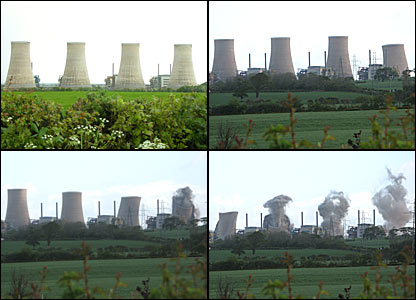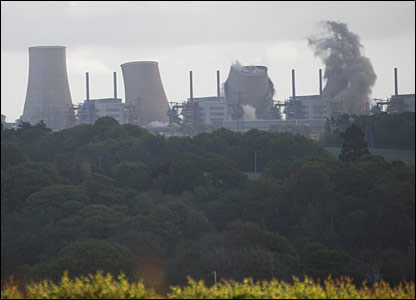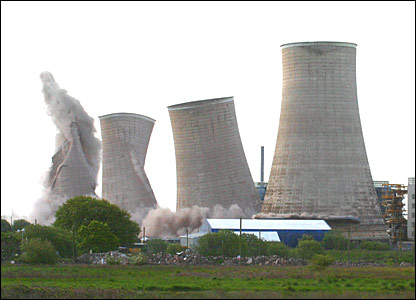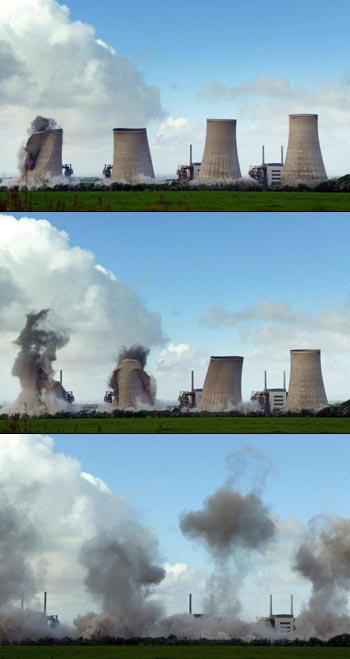 [Images: Photos by Neil Burns capture the destruction; via the BBC].
[Images: Photos by Neil Burns capture the destruction; via the BBC].
The BBC posted a short photo-spread today that looks at the implosion of four cooling towers at the Chapelcross nuclear power station, in Scotland, where the UK used to produce weapons-grade plutonium.
“The towers were brought down in 10 seconds, generating an estimated 25,000 tonnes of rubble,” we read.

 [Images: Photos by Andrew Turner and John Smith; via the BBC].
[Images: Photos by Andrew Turner and John Smith; via the BBC].
I think it’s interesting, though, that the towers seem to crimp and torque in some of these pictures, almost whirling, or folding, down onto themselves like some kind of self-imploding Richard Serra sculpture, made of lead-reinforced concrete. Might demolition somehow reveal other geometries and architectural forms – otherwise unknown material tendencies held at bay by engineering?
 [Images: Via The Scotsman].
[Images: Via The Scotsman].
In loosely related news, meanwhile, I’m excited to announce that Jeff Byles, author of Rubble: Unearthing the History of Demolition, will now be speaking at Postopolis! next week – so if you’ve got a soft spot for demolition, and the various arguments surrounding it, please stop by! More speakers to be announced shortly, including an up-to-date schedule.
watch it on youtube http://www.youtube.com/watch?v=3h0OFZVRWQU
Amazing!
Congratulations for a lovely blog… From another Architecture blogger (in Spanish):
http://diasdearquitectura.blogspot.com
All the best from Barcelona!
Xavier
If this is a nuclear power station, why do the boilers have smokestacks?
It’s for the exhaust coming off the reactors. These are cooling towers, but there is still steam coming off there. You can read about that here:
http://www.damninteresting.com/?p=842
There’s a campaign in and around Sheffield, UK, to preserve the twin cooling towers at Tinsley, and even to transform them into massive works of public art. The towers serve as landmarks for drivers on the M1 motorway, with many considering them as marking the boundary between the North and South of England. Recent update on developments here – http://www.2ubh.com/view/2007/04/tinsley-tower-competition.html
I would really like to see the towers preserved, But equally, if they’ve got to go, I really want to be there to see them come down.
Check out the menacing bushy-eyebrowed face formed from the smoke in image #9 in the BBC slideshow.
http://news.bbc.co.uk/2/hi/in_pictures/6673905.stm
Not only should the cooling towers be preserved – they should be designated protected ecologies for endangered emergent species – evolutionary hotspots for new biodiversity!
Not only do they twist and turn, they seem to do so in relationship to one another.
Even in demolition, there’s context.